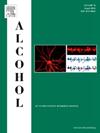Time-course concentration of ethanol, acetaldehyde and acetate in rat brain dialysate following alcohol self-administration
IF 2.5
4区 医学
Q3 PHARMACOLOGY & PHARMACY
引用次数: 0
Abstract
The unclear mechanisms of ethanol metabolism in the brain highlight the need for a deeper understanding of its metabolic pathways. This study used in vivo microdialysis to simultaneously sample ethanol and its metabolites, acetaldehyde and acetate, in the rat striatum following self-administration of ethanol, emphasizing the natural oral exposure route. To enhance the self-administration, rats underwent two-bottle-choice and limited access training. Dialysate samples, collected every 10 min for 2.5 h, were analyzed using gas chromatography with flame ionization detection (GC-FID). The measured time courses of dialysate concentrations of ethanol, acetaldehyde, and acetate provided insights into dynamics of ethanol metabolism. Notably, in a subject with low ethanol consumption (0.29 g/kg), the concentration of acetaldehyde remained below the limit of detection throughout the experiment. However, the acetate concentration was clearly increased after ethanol consumption in this subject and was comparable to that of other rats with higher ethanol consumption. Compared with focusing only on peak values in the time-courses of concentrations of ethanol and its metabolites, calculating areas under curves provided better models of the relationships between ethanol intake and individual ethanol metabolites, as indicated by the R-square values for the linear regressions. This approach of using the area under the curve accounts for both the amplitude and duration of the concentration profiles, reducing the impact of variations in individual drinking patterns. In vivo microdialysis enables concurrent sampling of brain metabolites during oral ethanol administration, contributing insights into metabolite dynamics. To our knowledge, this paper is the first to report measurement of all three analytes in the brain following self-administration of ethanol. Future studies will explore regional variations and dynamics post-ethanol dependence, further advancing our understanding of ethanol metabolism in the brain.

酒精自我摄取后大鼠脑透析液中乙醇、乙醛和乙酸酯的时程浓度。
乙醇在大脑中的代谢机制尚不清楚,因此需要更深入地了解其代谢途径。本研究采用体内微透析法,在大鼠自我给药乙醇后,同时对其纹状体中的乙醇及其代谢物乙醛和乙酸盐进行采样,强调自然的口服暴露途径。为了增强大鼠的自我给药能力,对大鼠进行了双瓶选择和有限接触训练。在 2.5 小时内,每隔 10 分钟收集一次透析液样本,并使用火焰离子化检测气相色谱法(GC-FID)进行分析。通过测量透析液中乙醇、乙醛和乙酸盐浓度的时间过程,可以了解乙醇代谢的动态变化。值得注意的是,在一个乙醇消耗量较低(0.29 克/千克)的受试者身上,乙醛的浓度在整个实验过程中都保持在检测限以下。然而,该实验对象在摄入乙醇后乙酸盐浓度明显升高,与其他乙醇摄入量较高的大鼠的乙酸盐浓度相当。与只关注乙醇及其代谢物浓度时间序列的峰值相比,计算曲线下面积能更好地模拟乙醇摄入量与单个乙醇代谢物之间的关系,这一点可以从线性回归的 r 平方值中看出。这种使用曲线下面积的方法同时考虑了浓度曲线的振幅和持续时间,减少了个人饮酒模式变化的影响。体内微透析法可在口服乙醇期间对脑代谢物进行同步采样,有助于深入了解代谢物的动态变化。据我们所知,本文首次报道了自我给药乙醇后大脑中所有三种分析物的测量结果。未来的研究将探索乙醇依赖后的区域变化和动态变化,进一步加深我们对乙醇在大脑中代谢的了解。
本文章由计算机程序翻译,如有差异,请以英文原文为准。
求助全文
约1分钟内获得全文
求助全文
来源期刊

Alcohol
医学-毒理学
CiteScore
4.60
自引率
4.30%
发文量
74
审稿时长
15.6 weeks
期刊介绍:
Alcohol is an international, peer-reviewed journal that is devoted to publishing multi-disciplinary biomedical research on all aspects of the actions or effects of alcohol on the nervous system or on other organ systems. Emphasis is given to studies into the causes and consequences of alcohol abuse and alcoholism, and biomedical aspects of diagnosis, etiology, treatment or prevention of alcohol-related health effects.
Intended for both research scientists and practicing clinicians, the journal publishes original research on the neurobiological, neurobehavioral, and pathophysiological processes associated with alcohol drinking, alcohol abuse, alcohol-seeking behavior, tolerance, dependence, withdrawal, protracted abstinence, and relapse. In addition, the journal reports studies on the effects alcohol on brain mechanisms of neuroplasticity over the life span, biological factors associated with adolescent alcohol abuse, pharmacotherapeutic strategies in the treatment of alcoholism, biological and biochemical markers of alcohol abuse and alcoholism, pathological effects of uncontrolled drinking, biomedical and molecular factors in the effects on liver, immune system, and other organ systems, and biomedical aspects of fetal alcohol spectrum disorder including mechanisms of damage, diagnosis and early detection, treatment, and prevention. Articles are published from all levels of biomedical inquiry, including the following: molecular and cellular studies of alcohol''s actions in vitro and in vivo; animal model studies of genetic, pharmacological, behavioral, developmental or pathophysiological aspects of alcohol; human studies of genetic, behavioral, cognitive, neuroimaging, or pathological aspects of alcohol drinking; clinical studies of diagnosis (including dual diagnosis), treatment, prevention, and epidemiology. The journal will publish 9 issues per year; the accepted abbreviation for Alcohol for bibliographic citation is Alcohol.
 求助内容:
求助内容: 应助结果提醒方式:
应助结果提醒方式:


